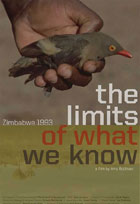
The Limits of What We Know 2009
Distributed by Canadian Filmmakers Distribution Centre, 401 Richmond St. W., Suite 119, Toronto, Ontario, Canada M5V 3A8; 416-588-0725
Produced by Amy Bodman
Directed by Amy Bodman
DVD, color, 94 min.
Jr. High - Adult
African Studies, Anthropology, Environmental Studies, Zimbabwe, Postcolonialism
Date Entered: 04/08/2010
Reviewed by Sue F. Phelps, Washington State University, Vancouver, WAThe Limits of What We Know is the first feature length documentary produced by Amy Bodman. In it Ms. Bodman paints a tender portrait of Zimbabwe through the people and the land from ancient times to the present. The picture comes to life through a series of interviews beginning with a history of the first settlement and the people who lived in “Great Zimbabwe”. Each interview has a title and becomes a vignette depicting a time, place, or aspect of the changing canvas of life in a changing landscape.
Other vignettes are: “Composition of a Drought,” an interview with a woodcarver whose totems depict the affects of drought on people. “The Culture of Cattle,” is a glimpse into the world of cattle herding. “A Map of the World” is a tour of a natural landscape that mimics the outline of world geography.” Rain” documents rain making music and dance. “Lake Kariba” tells the history of the making of the world’s largest man-made lake. “On Safari” takes us on a trip through the land of lions and giraffes. “Land Without Animals” explains the clash between the national parks and poachers. “Forms of Erosion” makes clear the consequences of poor land management. “Change” reminds us that nature adapts to change when allowed to do so. “Daniel’s Story” is about a three year game of hide and seek between two dogs and a hippo. “Clay” shows the hands of a woman elder creating a pot. “The Language of Trees” delineates the fascinating details of the botany of trees and survival. “Road makers of the Bush” allows that though man may believe he understands ecology the relationship between animals and the earth does not benefit from man’s interference. And the final vignette is “Spirits” which takes the viewers to sacred places in Zimbabwe where history and spiritual practices are explained.
It is the story of a country told with affection. Throughout the documentary the cinematography is beautiful. From the vast landscapes of the countryside to city life with close ups of animals, plants, art, instruments and people the imagery feels like the viewer is present. The pace is slow and gives the impression of a cross cultural experience.
The only disappointment is that occasionally the accents of the English speakers are difficult to understand. Though it may detract from the artistic nature of the film to add subtitles it would certainly benefit the listener who would like to hear all of the details of the stories. Of note is the focus on elements of the country and her people without lengthy discussion of government, politics, human rights, and Zimbabweans leaving the country to become refugees because of the economy.
This film would be an excellent addition to a public library or academic library that supports programs in anthropology, history, African studies or cultural studies.